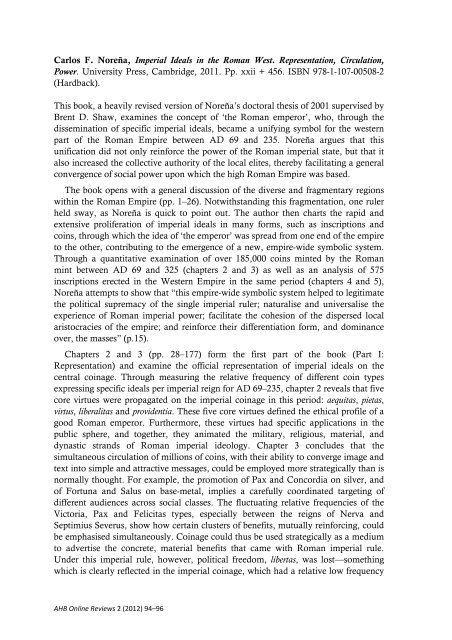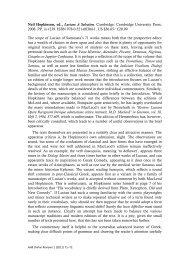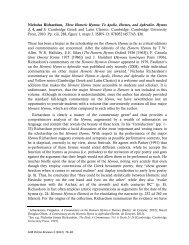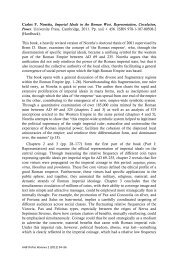Carlos F. Noreña, Imperial Ideals in the Roman West ...
Carlos F. Noreña, Imperial Ideals in the Roman West ...
Carlos F. Noreña, Imperial Ideals in the Roman West ...
You also want an ePaper? Increase the reach of your titles
YUMPU automatically turns print PDFs into web optimized ePapers that Google loves.
<strong>Carlos</strong> F. <strong>Noreña</strong>, <strong>Imperial</strong> <strong>Ideals</strong> <strong>in</strong> <strong>the</strong> <strong>Roman</strong> <strong>West</strong>. Representation, Circulation,<br />
Power. University Press, Cambridge, 2011. Pp. xxii + 456. ISBN 978-1-107-00508-2<br />
(Hardback).<br />
This book, a heavily revised version of <strong>Noreña</strong>’s doctoral <strong>the</strong>sis of 2001 supervised by<br />
Brent D. Shaw, exam<strong>in</strong>es <strong>the</strong> concept of ‘<strong>the</strong> <strong>Roman</strong> emperor’, who, through <strong>the</strong><br />
dissem<strong>in</strong>ation of specific imperial ideals, became a unify<strong>in</strong>g symbol for <strong>the</strong> western<br />
part of <strong>the</strong> <strong>Roman</strong> Empire between AD 69 and 235. <strong>Noreña</strong> argues that this<br />
unification did not only re<strong>in</strong>force <strong>the</strong> power of <strong>the</strong> <strong>Roman</strong> imperial state, but that it<br />
also <strong>in</strong>creased <strong>the</strong> collective authority of <strong>the</strong> local elites, <strong>the</strong>reby facilitat<strong>in</strong>g a general<br />
convergence of social power upon which <strong>the</strong> high <strong>Roman</strong> Empire was based.<br />
The book opens with a general discussion of <strong>the</strong> diverse and fragmentary regions<br />
with<strong>in</strong> <strong>the</strong> <strong>Roman</strong> Empire (pp. 1–26). Notwithstand<strong>in</strong>g this fragmentation, one ruler<br />
held sway, as <strong>Noreña</strong> is quick to po<strong>in</strong>t out. The author <strong>the</strong>n charts <strong>the</strong> rapid and<br />
extensive proliferation of imperial ideals <strong>in</strong> many forms, such as <strong>in</strong>scriptions and<br />
co<strong>in</strong>s, through which <strong>the</strong> idea of ‘<strong>the</strong> emperor’ was spread from one end of <strong>the</strong> empire<br />
to <strong>the</strong> o<strong>the</strong>r, contribut<strong>in</strong>g to <strong>the</strong> emergence of a new, empire-wide symbolic system.<br />
Through a quantitative exam<strong>in</strong>ation of over 185,000 co<strong>in</strong>s m<strong>in</strong>ted by <strong>the</strong> <strong>Roman</strong><br />
m<strong>in</strong>t between AD 69 and 325 (chapters 2 and 3) as well as an analysis of 575<br />
<strong>in</strong>scriptions erected <strong>in</strong> <strong>the</strong> <strong>West</strong>ern Empire <strong>in</strong> <strong>the</strong> same period (chapters 4 and 5),<br />
<strong>Noreña</strong> attempts to show that “this empire-wide symbolic system helped to legitimate<br />
<strong>the</strong> political supremacy of <strong>the</strong> s<strong>in</strong>gle imperial ruler; naturalise and universalise <strong>the</strong><br />
experience of <strong>Roman</strong> imperial power; facilitate <strong>the</strong> cohesion of <strong>the</strong> dispersed local<br />
aristocracies of <strong>the</strong> empire; and re<strong>in</strong>force <strong>the</strong>ir differentiation form, and dom<strong>in</strong>ance<br />
over, <strong>the</strong> masses” (p.15).<br />
Chapters 2 and 3 (pp. 28–177) form <strong>the</strong> first part of <strong>the</strong> book (Part I:<br />
Representation) and exam<strong>in</strong>e <strong>the</strong> official representation of imperial ideals on <strong>the</strong><br />
central co<strong>in</strong>age. Through measur<strong>in</strong>g <strong>the</strong> relative frequency of different co<strong>in</strong> types<br />
express<strong>in</strong>g specific ideals per imperial reign for AD 69–235, chapter 2 reveals that five<br />
core virtues were propagated on <strong>the</strong> imperial co<strong>in</strong>age <strong>in</strong> this period: aequitas, pietas,<br />
virtus, liberalitas and providentia. These five core virtues def<strong>in</strong>ed <strong>the</strong> ethical profile of a<br />
good <strong>Roman</strong> emperor. Fur<strong>the</strong>rmore, <strong>the</strong>se virtues had specific applications <strong>in</strong> <strong>the</strong><br />
public sphere, and toge<strong>the</strong>r, <strong>the</strong>y animated <strong>the</strong> military, religious, material, and<br />
dynastic strands of <strong>Roman</strong> imperial ideology. Chapter 3 concludes that <strong>the</strong><br />
simultaneous circulation of millions of co<strong>in</strong>s, with <strong>the</strong>ir ability to converge image and<br />
text <strong>in</strong>to simple and attractive messages, could be employed more strategically than is<br />
normally thought. For example, <strong>the</strong> promotion of Pax and Concordia on silver, and<br />
of Fortuna and Salus on base-metal, implies a carefully coord<strong>in</strong>ated target<strong>in</strong>g of<br />
different audiences across social classes. The fluctuat<strong>in</strong>g relative frequencies of <strong>the</strong><br />
Victoria, Pax and Felicitas types, especially between <strong>the</strong> reigns of Nerva and<br />
Septimius Severus, show how certa<strong>in</strong> clusters of benefits, mutually re<strong>in</strong>forc<strong>in</strong>g, could<br />
be emphasised simultaneously. Co<strong>in</strong>age could thus be used strategically as a medium<br />
to advertise <strong>the</strong> concrete, material benefits that came with <strong>Roman</strong> imperial rule.<br />
Under this imperial rule, however, political freedom, libertas, was lost—someth<strong>in</strong>g<br />
which is clearly reflected <strong>in</strong> <strong>the</strong> imperial co<strong>in</strong>age, which had a relative low frequency<br />
AHB Onl<strong>in</strong>e Reviews 2 (2012) 94–96
Liesbeth Claes on <strong>Carlos</strong> <strong>Noreña</strong>, <strong>Imperial</strong> <strong>Ideals</strong> <strong>in</strong> <strong>the</strong> <strong>Roman</strong> <strong>West</strong><br />
of libertas types. In contrast to <strong>the</strong> general assumption that libertas was a key imperial<br />
ideal, <strong>the</strong> central co<strong>in</strong>age <strong>in</strong>dicates that this ideal actually played a negligible role <strong>in</strong><br />
imperial publicity.<br />
The second part (Part II: Circulation), conta<strong>in</strong><strong>in</strong>g chapters 4 and 5 (pp. 180–297),<br />
describes and analyses how <strong>the</strong> ideals and imperial benefits exam<strong>in</strong>ed <strong>in</strong> chapters 2<br />
and 3 were communicated. In this part <strong>the</strong> <strong>in</strong>terdiscipl<strong>in</strong>ary character of <strong>Noreña</strong>’s<br />
research comes clearly to <strong>the</strong> fore. In <strong>the</strong> <strong>in</strong>troduction, he sets off with a discussion<br />
about <strong>the</strong> authority or authorities beh<strong>in</strong>d <strong>the</strong> <strong>in</strong>scriptions concern<strong>in</strong>g <strong>the</strong> emperor, to<br />
see which, if any, can be perceived as “official”. On <strong>the</strong> basis of a corpus of 575<br />
<strong>in</strong>scriptions, he creates a hierarchy of different types of <strong>in</strong>scriptions runn<strong>in</strong>g from<br />
more “official” to more “unofficial”.<br />
In chapter 4, <strong>Noreña</strong> starts to analyse <strong>the</strong> diffusion of imperial ideals throughout<br />
<strong>the</strong> Empire through honorific <strong>in</strong>scriptions (e.g. on statue bases, milestones, ect) from<br />
AD 69 to 235, from which he is able to highlight two <strong>in</strong>terest<strong>in</strong>g features. The first is<br />
<strong>the</strong> difference <strong>in</strong> language content. Inscriptions from AD 69 to Marcus Aurelius’<br />
reign primarily employ <strong>the</strong> honorific language for virtues and civic benefaction,<br />
whereas <strong>the</strong> language employed <strong>in</strong> <strong>the</strong> <strong>in</strong>scriptions from Commodus’ reign to AD 235<br />
is embedded <strong>in</strong> a martial context. Later <strong>in</strong> this chapter, <strong>Noreña</strong> compares this<br />
divergence with <strong>the</strong> messages broadcast on imperial denarii. The second feature is<br />
geographical. From AD 69 to 192 most <strong>in</strong>scriptions were set up <strong>in</strong> Rome, Italy,<br />
North Africa, sou<strong>the</strong>rn Spa<strong>in</strong>, and <strong>the</strong> Mediterranean coasts of Spa<strong>in</strong> and Gaul, while<br />
many from AD 193 to 235 AD were set up along <strong>the</strong> Rh<strong>in</strong>e-Danube corridor as well.<br />
<strong>Noreña</strong> <strong>the</strong>n compares <strong>the</strong> honorific term<strong>in</strong>ology employed <strong>in</strong> official <strong>in</strong>scriptions<br />
with <strong>the</strong> ideals and values represented on imperial co<strong>in</strong>s, result<strong>in</strong>g <strong>in</strong> a splendid piece<br />
of <strong>in</strong>terdiscipl<strong>in</strong>ary scholarship. By means of concrete examples, a section shows how<br />
specific honorific epi<strong>the</strong>ts <strong>in</strong> <strong>in</strong>scriptions of a particular reign resonate <strong>in</strong> <strong>the</strong> imperial<br />
co<strong>in</strong>s issued dur<strong>in</strong>g that reign, or how <strong>the</strong> emphasis on particular virtues on <strong>the</strong> co<strong>in</strong>s<br />
could correspond to similar citations of <strong>the</strong>se ideals <strong>in</strong> <strong>the</strong> <strong>in</strong>scriptions. As mentioned<br />
above, <strong>Noreña</strong> goes even fur<strong>the</strong>r, by analys<strong>in</strong>g <strong>the</strong> “civilian” and “military”<br />
personification types on imperial denarii <strong>in</strong> order to expla<strong>in</strong> <strong>the</strong> shift to a more<br />
martial language <strong>in</strong> <strong>the</strong> <strong>in</strong>scriptions from Commodus’ reign onwards.<br />
Chapter 5 turns to <strong>the</strong> “unofficial” <strong>in</strong>scriptions honour<strong>in</strong>g <strong>the</strong> emperor, set up by<br />
local aristocrats or communities. Multiple examples of <strong>the</strong>se honorific dedications<br />
show a picture of broad overlap, both lexical and ideological, between imperial<br />
honorific terms and ideals communicated by <strong>the</strong> central state and those cited <strong>in</strong> <strong>the</strong>se<br />
“unofficial” <strong>in</strong>scriptions, and this <strong>in</strong> a far-flung pre-<strong>in</strong>dustrial Empire. <strong>Noreña</strong> also<br />
manages to sketch out how <strong>the</strong>se honorific <strong>in</strong>scriptions concern<strong>in</strong>g <strong>the</strong> emperor were<br />
produced spontaneously and that by local <strong>in</strong>itiative, who <strong>in</strong> turn also benefitted from<br />
this association with <strong>the</strong> emperor.<br />
The f<strong>in</strong>al part (III: Power) (pp. 300–324) conta<strong>in</strong>s a s<strong>in</strong>gle conclud<strong>in</strong>g chapter<br />
which focuses on ideological unification and social power <strong>in</strong> <strong>the</strong> <strong>Roman</strong> <strong>West</strong>. Here<br />
<strong>Noreña</strong> argues that imperial ideals and values penetrated prov<strong>in</strong>cial societies <strong>in</strong> a<br />
broad and potentially deep way, and subsequently, that <strong>the</strong> local authorities<br />
contributed to it. Thus <strong>the</strong>se concepts provided for <strong>the</strong> Empire a “symbolic glue” that<br />
enabled at least a measure of ideological unification between <strong>the</strong> multiple actors who<br />
Page 95
Page 96<br />
Liesbeth Claes on <strong>Carlos</strong> <strong>Noreña</strong>, <strong>Imperial</strong> <strong>Ideals</strong> <strong>in</strong> <strong>the</strong> <strong>Roman</strong> <strong>West</strong><br />
controlled <strong>the</strong> ma<strong>in</strong> power networks of <strong>the</strong> <strong>Roman</strong> Empire, provid<strong>in</strong>g a stable basis<br />
for its long-term ma<strong>in</strong>tenance and <strong>the</strong> reproduction of <strong>the</strong> larger configuration of<br />
power.<br />
The book closes with a battery of appendices, ma<strong>in</strong>ly clarify<strong>in</strong>g <strong>the</strong> calculations<br />
beh<strong>in</strong>d <strong>Noreña</strong>’s sets of co<strong>in</strong> percentages <strong>in</strong> <strong>the</strong> different chapters. The illustrations <strong>in</strong><br />
<strong>the</strong> book, such as co<strong>in</strong> plates, maps, and graphs, are marvellous, and clearly<br />
contribute to a better understand<strong>in</strong>g of <strong>Noreña</strong>’s arguments. This book is certa<strong>in</strong>ly<br />
important to all scholars <strong>in</strong>terested <strong>in</strong> how power can be transmitted.<br />
LIESBETH CLAES<br />
RADBOUD UNIVERSITY NIJMEGEN







